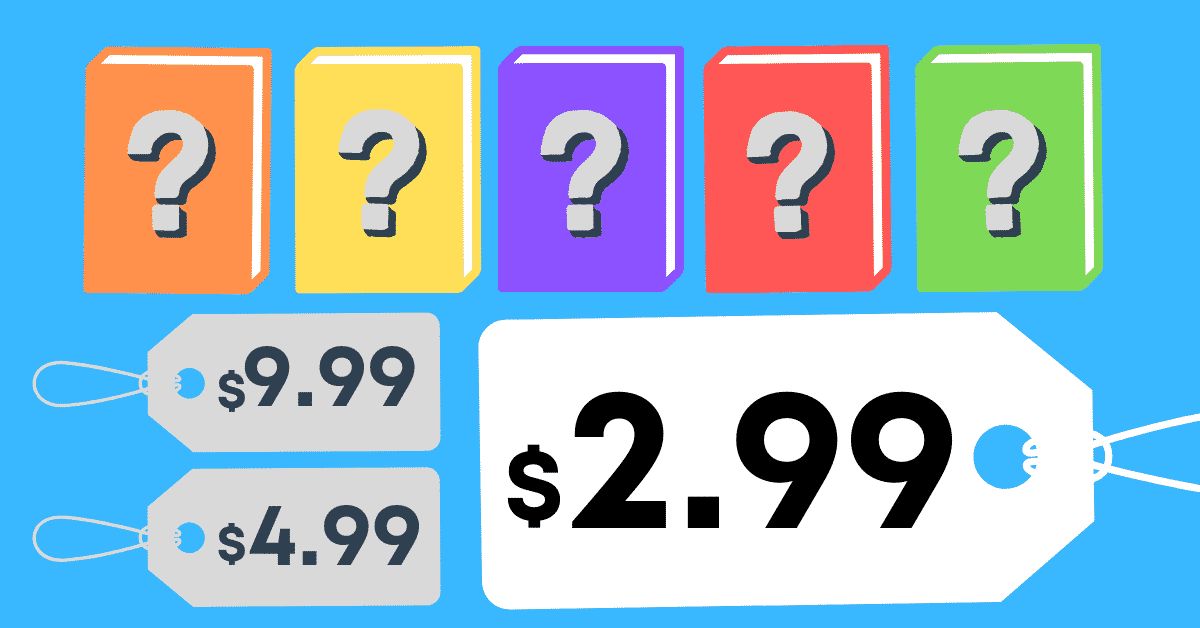Introduction
Welcome to the world of eBooks! In this digital age, eBooks have gained immense popularity and have revolutionized the way we read and access information. With the convenience of digital devices, the popularity of eBooks continues to grow, making them a thriving market for both readers and authors alike.
When it comes to eBook pricing, there are several factors to consider. Whether you’re an author exploring self-publishing options or a reader curious about how eBook prices are determined, understanding the various factors and strategies behind eBook pricing can provide valuable insights.
In this article, we will delve into the intricacies of eBook pricing, exploring the costs involved, factors influencing pricing decisions, and different pricing strategies employed by authors and publishers. We will also examine case studies to gain a better understanding of how pricing impacts the success of an eBook.
Before we explore the details, it’s important to differentiate between traditional publishing and self-publishing. Traditional publishing involves an author signing a contract with a publishing house, while self-publishing allows authors to independently release their works digitally without the intervention of a publishing house. The different approaches to publishing can have a significant impact on eBook pricing.
So, whether you’re an aspiring author exploring your options or a curious reader interested in the behind-the-scenes workings of the eBook industry, get ready to embark on a journey to uncover the mysteries of eBook pricing!
Understanding eBook Pricing Factors
Setting the right price for an eBook involves careful consideration of various factors. Understanding these factors can help authors and publishers make informed decisions about how to price their eBooks. Let’s explore some key elements that influence eBook pricing.
1. Production Costs: Unlike traditional printed books, eBooks eliminate the need for physical production and distribution. However, there are still costs associated with eBook production, such as editing, formatting, cover design, and eBook conversion. These costs can vary depending on the complexity of the book and the level of professional assistance required.
2. Market Demand: The law of supply and demand plays a significant role in pricing eBooks. If a particular genre or topic is in high demand, authors and publishers may set higher prices to capitalize on the popularity. Conversely, if a book is in a less popular niche, pricing may be adjusted downward to attract more readers.
3. Book Length and Complexity: eBook prices often reflect the length and complexity of the content. Longer and more intricate books may be priced higher, as they typically require more time and effort to produce. Conversely, shorter and simpler books may be priced lower to appeal to a wider audience.
4. Author Reputation and Brand: Established authors with a strong reputation and established reader base often command higher eBook prices. Readers are willing to pay a premium for works by authors they trust and admire. On the other hand, new and lesser-known authors may price their eBooks competitively to attract readers and build their fan base.
5. Market Competition: The competitive landscape of the eBook market also affects pricing decisions. If a book faces stiff competition from similar titles, authors and publishers may adjust the price to stand out and offer additional value to potential readers.
6. eBook Format: Different eBook formats may impact pricing as well. For example, enhanced eBooks with multimedia elements like audio clips, videos, or interactive features may command higher prices due to the added production and development costs.
7. Profit Margins: Ultimately, authors and publishers aim to earn a profit from their eBook sales. Profit margins will vary depending on the pricing strategy, distribution platform fees, and other factors. Finding the right balance between pricing competitively and generating revenue is crucial.
Understanding these factors allows authors and publishers to make informed decisions when it comes to pricing their eBooks. By carefully considering production costs, market demand, book length, author reputation, market competition, eBook format, and profit margins, they can set appropriate prices that attract readers while ensuring a reasonable return on investment.
Traditional Publishing Costs
Traditional publishing involves working with a publishing house to release and distribute books. While eBooks eliminate certain physical production costs, there are still expenses associated with the traditional publishing process. Let’s take a closer look at these costs.
1. Editorial Services: One of the significant expenses in traditional publishing is hiring professional editors for manuscript review, copy editing, and proofreading. These services ensure the quality and integrity of the content before it reaches readers.
2. Cover Design and Layout: Captivating cover designs play a crucial role in grabbing readers’ attention. Traditional publishing incurs costs for cover design and layout, which are essential for creating an appealing visual representation of the book.
3. Marketing and Promotion: Publishers allocate a portion of their budget to marketing and promotion to generate awareness and drive sales. This may include advertisements, book tours, author events, online promotions, and collaborations with bookstores to showcase and distribute the book.
4. Printing and Distribution: Although we are discussing eBook pricing, it’s worth noting that traditional publishers may still produce physical copies of the book, particularly for hardcover editions or special editions. Printing costs, along with warehousing and distribution expenses, contribute to the overall publishing cost.
5. Publisher’s Overhead: Traditional publishing houses have operational expenses, including salaries, office space, technology, and other administrative costs. These overhead costs are factored into the overall expenses of publishing a book.
It’s important to remember that traditional publishing involves a shared revenue model, where authors receive a royalty percentage on each book sold. The publisher absorbs the upfront costs of production and distribution, recouping them from book sales before shared profits are generated.
These traditional publishing costs impact eBook pricing to some extent. While the digital nature of eBooks eliminates print and distribution expenses, there are still costs associated with editorial services, cover design, marketing, and publisher’s overhead. Authors and publishers need to factor in these expenses when determining the price of their eBooks.
Self-Publishing Costs
Self-publishing has become an increasingly popular option for authors to release their eBooks independently. While it offers more control and higher royalty rates, there are still costs involved in the self-publishing process. Let’s dive into the key expenses associated with self-publishing.
1. Editing and Proofreading: To ensure a professional final product, self-published authors often hire freelance editors or proofreaders to review their manuscripts. This ensures that the book is polished and error-free before it reaches readers.
2. Cover Design: Just like in traditional publishing, a captivating cover design is essential for self-published eBooks. Authors often hire professional graphic designers to create visually appealing covers that accurately represent the content and attract potential readers.
3. Formatting and Layout: Proper formatting and layout are crucial to presenting the eBook in an organized and readable manner. Self-published authors may opt to hire professionals or use software tools to ensure that their eBooks are correctly formatted for various devices and platforms.
4. Marketing and Promotion: Self-published authors are responsible for marketing and promoting their eBooks to reach their target audience. This may involve investing in online advertisements, social media marketing, book reviews, author websites, and other promotional activities to generate awareness and drive sales.
5. Distribution and Platform Fees: While self-publishing eliminates printing and physical distribution costs, authors still need to consider the fees associated with eBook distribution platforms. Popular platforms such as Amazon Kindle Direct Publishing (KDP) or Smashwords charge fees or take a percentage of the sales in exchange for the services they provide.
6. Author Website and Branding: Building an online presence is crucial for self-published authors. Expenses may include website development or maintenance, branding materials, and promotional content creation to establish a professional author brand.
7. Additional Services: Depending on the author’s budget and goals, there may be additional services to consider, such as professional book reviews, book trailers, or hiring a publicist to enhance the book’s visibility.
Self-published authors have the flexibility to choose which services they want to invest in based on their budget and goals. It’s important to carefully consider these costs while setting the eBook price to ensure a reasonable return on investment.
Factors Influencing eBook Pricing
Setting the right price for an eBook involves considering various factors that can influence its perceived value and market competitiveness. Here are some key factors that can play a significant role in determining the pricing of an eBook.
1. Genre and Market Trends: Different genres have varying price expectations. The popularity and demand for a particular genre can also impact eBook pricing. Bestselling genres may have higher price points, while niche or less popular genres may be priced lower to attract readers.
2. Author Reputation: The reputation and recognition of the author can greatly influence eBook pricing. Established and well-known authors can often command higher prices due to their loyal fan base and perceived value. On the other hand, new or lesser-known authors may price their eBooks lower to entice readers and gain exposure.
3. Book Quality and Content: The quality of the writing, editing, and overall presentation of an eBook can affect its perceived value. eBooks that offer well-researched, compelling content and a professional finish are more likely to justify higher price points.
4. Unique Selling Proposition: Having a unique selling proposition or special features can justify higher eBook prices. Enhanced eBooks with multimedia elements, bonus content, or interactive features may command higher prices due to the added value they offer compared to standard eBooks.
5. Pricing of Competing Books: The pricing of similar books in the market can influence eBook pricing decisions. Authors and publishers may choose to price their eBooks competitively or strategically adjust the price to differentiate themselves from the competition. They need to consider the perceived value of their eBook compared to others in the same genre or category.
6. Target Audience and Demographics: Understanding the target audience and their willingness to pay for eBooks is crucial in setting an appropriate price. Factors such as age, income level, and geographic location can influence the perceived value and affordability of an eBook for a particular audience.
7. eBook Format and Features: eBooks are available in various formats, such as PDF, ePub, and Kindle. The compatibility of the eBook with different devices and platforms can impact pricing decisions. Additionally, eBooks with unique features like audiobooks, interactive quizzes, or video content may have higher price points to account for the extra production costs.
By carefully considering these factors, authors and publishers can establish a pricing strategy that aligns with the market, their target audience, and the value they provide. Taking into account genre trends, author reputation, book quality, competition, target audience, and eBook format can help determine an optimal price range for an eBook.
Pricing Strategies for eBooks
Setting the right price for an eBook is a balancing act between attracting readers and generating revenue. Authors and publishers employ various pricing strategies to maximize sales and optimize profits. Let’s explore some common pricing strategies for eBooks:
1. Market-Based Pricing: This strategy involves setting the eBook price based on market research and analysis of similar titles in the genre. By pricing the eBook competitively within the market, authors aim to attract readers and stand out among the competition.
2. Value-Based Pricing: Value-based pricing focuses on the perception of the eBook’s value by the target audience. It takes into consideration factors such as the author’s reputation, content quality, unique selling proposition, and reader demand. eBooks with higher perceived value may be priced at a premium to reflect their worth.
3. Dynamic Pricing: Dynamic pricing involves adjusting the eBook price based on market conditions, reader demand, or promotional periods. For instance, authors may offer limited-time discounts or promotional prices to attract new readers or boost sales during specific events or holidays. The flexibility of digital publishing allows for quick adjustments to adapt to changing market dynamics.
4. Bundling: Bundling involves offering multiple eBooks or related digital products as a package at a discounted price. This strategy can increase the perceived value for readers and incentivize them to purchase more than one eBook. Bundling can also help promote backlist titles or introduce readers to a new series or author.
5. Free or Low-Cost Pricing: Giving away an eBook for free or at a low cost can be a strategic move to attract new readers, generate buzz, and build an author’s fan base. It can serve as a marketing tool to entice readers to try the author’s work with the hope of converting them into loyal readers who will purchase future eBooks at regular prices.
6. Subscription/Access Models: Some authors and publishers opt for subscription models where readers pay a monthly or annual fee to access a library of eBooks. This model provides a steady stream of revenue and can be appealing to avid readers who consume multiple eBooks regularly.
It’s important to note that pricing strategies may vary depending on factors such as author goals, target audience, book genre, and market trends. Experimentation, market research, and analysis of sales data can help determine the most effective pricing strategy for each eBook.
By employing these pricing strategies, authors and publishers can find a balance between attracting readers, maximizing sales, and ensuring a reasonable return on investment for their eBooks.
Case Studies of eBook Pricing
Examining real-life case studies of eBook pricing can provide valuable insights into the impact of different pricing strategies and their effects on sales and revenue. Let’s explore a few notable examples:
1. “The Martian” by Andy Weir: When self-published author Andy Weir released “The Martian,” he initially priced the eBook at just $0.99. This low-cost strategy attracted a large number of readers, leading to positive word-of-mouth promotion and eventually catching the attention of a traditional publisher. The eBook went on to become a bestseller and was later adapted into a successful film.
2. “Harry Potter” series by J.K. Rowling: Despite the immense popularity of the “Harry Potter” series, J.K. Rowling and her publishers maintained steady pricing throughout the eBook editions. This approach aimed to preserve the perceived value of the books and avoid devaluing the entire series.
3. Kindle Daily Deal by Amazon: Amazon’s Kindle Daily Deal features discounted eBook titles for a limited time. This promotion grabs readers’ attention and encourages impulse purchases. The time-limited discount creates a sense of urgency and drives sales, benefiting both authors and readers.
4. “Fifty Shades of Grey” by E.L. James: The eBook pricing strategy played a significant role in the success of the “Fifty Shades of Grey” trilogy. By initially offering the first book in the series at a low price and leveraging online marketing and buzz, E.L. James attracted millions of readers, which led to increased sales for the subsequent books.
5. “The Hunger Games” series by Suzanne Collins: Suzanne Collins’ “The Hunger Games” series achieved substantial success by offering the first eBook in the series at a lower price compared to the subsequent books. This strategy served as an entry point for readers, enticing them to invest in the remaining books of the series at higher price points.
6. “The Girl on the Train” by Paula Hawkins: Before its release, “The Girl on the Train” by Paula Hawkins generated significant buzz and anticipation. The publishers set a higher price for the eBook to capitalize on the hype and create an aura of exclusivity. The strategy proved successful, with the eBook becoming a bestseller.
These case studies highlight the importance of strategic pricing in the success of eBooks. They demonstrate how different pricing strategies, such as low-cost promotions, maintaining consistent pricing, limited-time discounts, and strategic series pricing, can drive sales and impact the overall success of an eBook.
By analyzing these case studies and understanding the factors that contributed to their success, authors and publishers can make informed decisions regarding their own eBook pricing strategies.
Conclusion
Setting the right price for an eBook is a crucial aspect of the publishing process. It requires careful consideration of various factors, including production costs, market demand, author reputation, genre trends, and target audience. The decision to pursue traditional publishing or self-publishing also impacts eBook pricing.
Understanding the dynamics of eBook pricing allows authors and publishers to strategically position their eBooks in the market, attract readers, and generate revenue. By employing pricing strategies such as market-based pricing, value-based pricing, dynamic pricing, bundling, or free/low-cost pricing, they can optimize their eBook sales and maximize profitability.
Real-life case studies further illustrate the impact of pricing decisions on eBook success. Examples like “The Martian,” “Harry Potter,” and “Fifty Shades of Grey” demonstrate the different strategies authors have employed to achieve remarkable results.
It is important for authors and publishers to continuously evaluate and adjust their pricing strategies based on market trends, reader feedback, and sales data. By monitoring the performance of their eBooks and analyzing the effects of pricing decisions, they can optimize their pricing strategies for long-term success.
Ultimately, finding the right balance between attracting readers, generating revenue, and ensuring a reasonable return on investment is the key to successful eBook pricing. By carefully considering the various factors influencing eBook pricing and employing effective pricing strategies, authors and publishers can navigate the digital landscape with confidence, captivate readers, and thrive in the competitive world of eBooks.

























